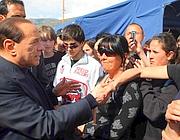Comment: Quake underlines Italy’s sad legacy of corruption

The recent earthquake that struck Italy is a vivid example of the deadly consequences corruption in a government can have on a population. With a long history of earthquakes in her past, the Italian state failed to protect its citizens by enforcing anti-earthquake regulations that were passed by the government following the 1980 Naples earthquake that killed over 2,500 people. With a long history of illegal housing, Mafia-related construction companies, and a corrupt political system, the L’Aquila earthquake is stark reminder to Italians of the risks they take by tolerating a corrupt political system.
Many Italians evidently are resigned to the fact that they live in a corrupt and poorly run country. Highlighting this feeling is a remark from Franco Barberi, who heads a committee assessing earthquake risks at Italy’s Civil Protection agency.
In a recent interview, he said, “Once again we are faced with the lack of control on the quality of construction. In California, an earthquake like this one would not have killed a single person.”
Highlighting the inability of the government to enforce regulations is the San Salvatore hospital. According to one Italian media report, the hospital was finished in 2000. Designed to withstand the 6.3 magnitude quake that struck the area on Monday morning, part of the hospital collapsed and many of the patients had to be evacuated or treated outdoors. In addition to hospitals in Italy being built with inferior building materials and lax enforcement of building regulations, the European Centre for Research in Earthquake Engineering, said 80,000 public buildings in Italy are unsafe. Many of these buildings include hospitals like San Salvatore and public school buildings. In the not so distant past in 2002, an earthquake in San Giuliano di Puglia killed 26 schoolchildren.
While Italian Prime Mnister Silvio Berlusconi says the Italian state will rebuild the towns that have been destroyed, the track record of the Italian state rebuilding areas hit by an earthquake is marginally at best.
Following the 1968 earthquake in the poverty stricken area of Belice in north-west Sicily, where over 500 people were killed and another 90,000 thousand homeless, political leaders were also quick to offer aid to the people affected by the disaster. However, 9 years after the earthquake struck, there were still over 60,000 people living in the Nissen huts, which had been erected immediately after the earthquake.
Highlighting the corrupt nature of the political system here in Italy and the links to the mafia, most of the money that was approved to provide housing for those earthquake victims, was spent on needless construction projects.
Therefore, when Sig. Berlusconi says that the Italian state is going to rebuild entire towns in 24-28 months, any casual observer to Italian society would know this is unrealistic. Completing a major public works project in Italy takes slightly less than six years and costs four times more than in other European countries.
Like previous Italian political leaders have done in Italy, Sig. Berlusconi will use the latest earthquake for his own personal and political gain by giving out generous building contracts to further increase his political party’s power and control of the country.
Paul Scaglia is a Rome-based political scientist and development consultant.


